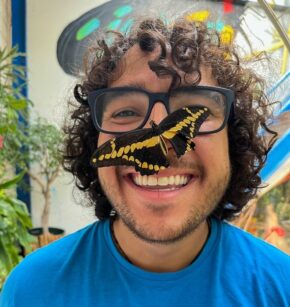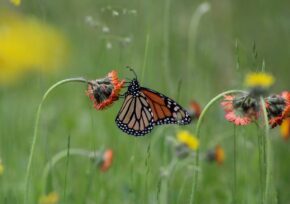
This summer, the MJV is managing two California monitoring projects designed to help quantify the presence (or absence) of monarchs and assess breeding habitat across diverse California landscapes. With the western monarch population in steep decline, this monitoring work is part of regional and national efforts to accelerate monarch conservation. Read our in-depth introduction to this summer’s California monitoring work here.
For the fourth consecutive year, we have field crews monitoring habitat restoration sites that are part of the National Fish and Wildlife Foundation (NFWF) Monarch Butterfly and Pollinators Conservation Fund. While previous years’ monitoring took place in the Midwest, 2022 monitoring is happening across California.

Eric Bastidas is one of our NFWF monarch monitoring field crew members this year. Originally from New Jersey, he went to the University of Maine, double-majoring in wildlife ecology and zoology. He has spent time exploring the U.S. recreationally and professionally. Avid backpacking experience has helped him attain many of his technician positions, for which he has worked with both pollinators and large mammals, including recent work as a mountain lion kill site investigation technician, and a black bear capture and camera trapping technician. He spends his free time outside with friends, and practicing photography…a perfect combination for an aspiring nature photographer and wildlife biologist.
The following essay and photos were contributed by Eric Bastidas.
“Excuse my bluntness, but why should we even care about monarchs? What do they DO?” a curious neighbor at my campsite asks me as I unpack the field vehicle. It’s a question I’ve been prompted to answer time and time again. My favorite response comes from the book Bicycling with Butterflies, by Sara Dykman (paraphrased): “Well… why should we care about YOU?” As tempting as it can be to come back with this sassy yet thought-provoking response, I carefully navigate my neighbor through the numerous reasons for the monarch butterfly and native pollinator conservation.
I compare the monarch’s journeys to a story’s protagonist, citing the many conflicts and challenges it may face during its annual migrations. His young son listens to me describe the ecosystem services and magic of several small yet crucial pollinating creatures, and I see his eyes glowing with astonishment and curiosity. Seeing the boy’s genuine interest and enthusiasm for the natural world reminds me of myself growing up.

Ever since I was little, I had an attraction to the “unattractive” parts of nature, which included a fascination for insects. Most children grow up with a natural curiosity toward the flora and fauna that surround them, but unfortunately, this tends to get molded out of people's interests as they grow up. Luckily for me, it was not.
Although monarch butterflies represent the more attractive part of the insect world, I always try to emphasize the importance of other pollinators such as beetles, flies, and native bees/wasps to name a few. My professional journey with monarch butterflies started when I worked for a graduate student, Emma Keele, last summer on a pollinator project in Minnesota and Wisconsin. This gave me a strong entomology knowledge, and being able to work in collaboration with the Monarch Joint Venture for my current project escalated my love for the charismatic monarch butterfly. The more I learned about its life histories and migration, the more I realized I wanted to know. Emma was a powerful force shaping the direction of my enthusiasm, for which I am grateful.

Through my work in the Great Lakes region, I quickly began to realize how much I enjoyed working with private landowners and the public. I started to become aware in college just how important it was that science gets properly communicated to the public in a way that is digestible and easy to comprehend. In my opinion, the miscommunication between the scientific world and the media (along with the public), is one of the most critical issues my generation needs to tackle. How are people supposed to care about something that they aren’t even aware of?

My hopes are that as I progress within the field of wildlife ecology, I can learn skills and methods to effectively change the dynamic between scientific research and the way the public sees the conflict between humans and wildlife. In my opinion, one of the most effective ways to connect people to some of these issues is with photography. It is easy to tell a person that native pollinator conservation is important, but if you do not expose (camera pun intended) them to what exactly native pollinators are, then a weak connection is formed. Showing someone a picture of a monarch butterfly feeding on a native plant while explaining some of the conflicts they face is much more memorable for that person, rather than telling them with no context.

Working with the Monarch Joint Venture has given me the wonderful opportunity to do exactly that. I am learning the best ways to effectively communicate the information that we are finding to a variety of stakeholders. Doing any sort of conservation work can be a bit mentally defeating at times; looking at the big picture can be hard because conservation efforts are not usually immediately met with tangible results, and there is a lag period. Explaining this to people can be tricky, but giving them hope for the future is a powerful thing. Being able to work in a field that I am passionate about is important to me because passion can be contagious. It is my goal to continue along this path in the wildlife ecology world and to introduce people to issues that they either may not be aware of, or to change their perspective possibly on an issue through education and outreach. Being able to explore so much of California has opened MY eyes to a world and lifestyle that isn’t common where I am from in New Jersey. Taking the lessons that I learn from here are an invaluable benefit to my long-term aspirations within my career.

